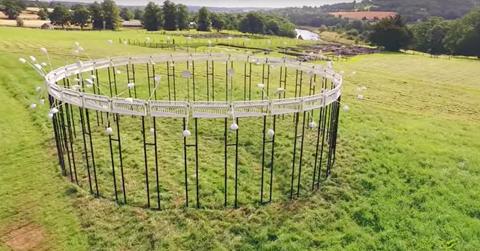Unique Installation Mimics Sound Of Galloping Horses Using Wind Energy
At the site of an ancient Roman fort, an artist has managed to bring back ghosts of the past through an installation that plays with sound and renewable power.
Updated May 23 2019, 9:41 a.m. ET
An architecture studio called NEON created at site-specific installation at the Chesters Roman Fort, in the north of England, that honors the history of the area while utilizing sustainable wind energy. Called Cavalry 360°, the piece is a large circle in which visitors can stand and hear the simulated sound of 500 cavalry horses galloping, as an ode to the army's stationed at Hadrian's Wall in the 2nd century.
Local paper Hadrian's Wall Country reports that the sculpture is comprised of 32 wind turbines, each of which has three arms with cups to catch the wind and power hundreds of "mini beaters," which then create the sound of equine hoofs in a constantly fluctuating pattern. The beaters are arranged to mimic a "Turma," a term in Latin term that refers to a Byzantine cavalry group of 30 horses.
"This should be an incredible experience for our visitors," said Kevin Booth, Senior Curator at English Heritage, which commissioned the piece. "A bespoke piece of work in a remarkable setting that will be both thought-provoking and fun. It is designed to connect the viewer with the environment, to invite people to look through the work at the landscape beyond, to pick up the sound on the wind, to experience the beaters working at differing speeds as the wind rises and falls – and as the horse gallops or trots. It will place you in the midst of a busy garrison, or give you a sense of a Roman cavalryman mid charge or as an aggressor awaiting their fate. Our ethos of ‘bringing history to life’ is perfectly encapsulated in this unique installation. This really is a once in a lifetime event and a first for English Heritage."
Mark Nixon, who owns NEON, explained that the installation is meant to make people consider the Roman conquerors who rode over the land almost 2,000 years ago. In a statement he wrote:
"This was an incredibly ambitious and challenging brief that called for a project that would retell the story of the Chester’s Cavalry in a way that would be engaging and exciting as well as drawing a new audience to the fort. The challenge of describing something that was no longer physically there, the Cavalry - and acknowledging the way the horse changed mankind’s relationship to the landscape were key to our approach for the commission. Like written fiction we were excited to offer a half description of the subject as a means of evoking the imagination of the viewer to fill in the gaps. The horse as a creature evokes a wide range of visual and audial motifs that gave us a rich palette from which to draw on."
The sculpture will be in place until November 5, and it may be your last chance to imagine Roman warriors crossing the land on their noble steeds, without even creating a carbon footprint.
